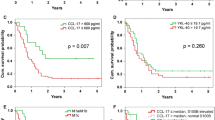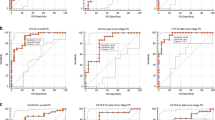Abstract
5-S-cysteinyldopa is a precursor of pheomelanin. S-100B protein is a low molecular weight, acidic, calcium binding, cytoplasmatic protein. LDH was defined as the most important serum parameter in disseminated melanoma. The aim of the present study was to compare the prognostic values of serum 5-S-Cysteinyldopa, S-100B and LDH concentrations in Stage III–IV melanoma patients. Serum samples were taken from 179 Stage III–IV melanoma patients at diagnosis. Serum 5-S-CD concentrations were determined by HPLC, S-100B protein by immunoluminometric assay while LDH by UV kinetic method. The mean/median concentrations of LDH, S-100B protein and 5-S-CD in Stage III patients ranged around the normal level. In Stage IV, the markers ranked as S100B = 5-S-CD > LDH for sensitivity, S-100B > LDH > 5-S-CD for specificity and LDH = S100B = 5-S-CD for positive predictive value, respectively. Furthermore, mean marker concentrations of patients with progressive disease differed significantly from nonprogresssive cases (when staging categories have been disregarded). Survival analysis indicated, that the initially elevated LDH and S-100B level in Stage IV disease predicts comparably short survival. Results of our study suggest that these serum marker values correlate well with Stages and disease progression. In Stage IV melanoma, the markers had appropriate sensitivity, high specificity as well as important positive predictive value. Among the studied serum markers S-100B protein and LDH proved to be similarly reliable in respect to the clinical outcome.
Similar content being viewed by others
References
Balch CM, Buzaid AC, Atkins MB et al: A new American Joint Committee on cancer staging system cutaneous melanoma. Cancer 88: 1484–1491, 2000
Bánfalvi T, Gilde K, Boldizsár M, et al: Serum levels of S-100 protein and 5-S-cysteinyldopa as markers of melanoma progression. Pathol Oncol Res 5: 218–223, 1999
Bánfalvi T, Gilde K, Boldizsár M, et al: Serum concentration of 5-S-cysteinyldopa in patients with melanoma. Eur J Clin Invest 30: 900–904, 2000
Benathan M, Labidi F: Modulation of 5-S-cysteinyldopa formation by tyrosinase activity and intracellular thiols in human melanoma cells. Melanoma Res 6: 183–189, 1996
Berking C, Schlüpen E, Schrader A, et al: Tumor markers in peripheral blood of patients with malignant melanoma: Multimarker RT-PCR versus a luminometric assay for S-100. Arch Dermatol Res 291: 479–484, 1999
Buer J, Probst M, Franzke A et al: Elevated serum levels of S100 and survival in metastatic malignant melanoma. Br J Cancer 75: 1373–1376, 1997
Buzaid AC, Ross MI, Balch CM, et al: Critical analysis of the current American Joint Committee on Cancer staging system for cutaneous melanoma and proposal of new staging system. J Clin Oncol 15: 1039–1051, 1997
Clark WH Jr,From L, Bernardino EA, Mihm MC: The histogenesis and biologic behaviour of primary human malignant melanomas of the skin. Cancer Res 29: 705–726, 1991
Deichmann M, Benner A, Bock Mjackel A, et al: S-100 beta, melanoma inhibiting activity and lactate dehydrogenase discriminate progressive from nonprogressive AJCC Stage IV melanoma. J Clin Oncol 17: 1891–1896, 1999
Deichmann M, Benner A, Kuner N et al: Are responses to therapy of metastatized melanoma reflected by decreasing serum values of S-100 beta or MIA? Melanoma Res. 11: 291–296, 2001
Djukanovic D, Hofmann U, Sucker A, et al: Comparison of S100 protein and MIA protein as serum markers in malignant melanoma. Anticancer Res 20: 2203–2207, 2000
Franzke A, Probst-kepper M, Buer J, et al: Elevated pretreatment serum levels of soluble vascular cell adhesion molecule 1 and lactate dehydrogenase as predictors of survival in cutaneous metastatic malignant melanoma. Br J Cancer 78: 40–45, 1998
Guo HB, Stoffel-Wagner B, Bierwirth T, et al: Clinical significance of serum S-100 in metastatic malignant melanoma. Eur J Cancer 31A: 1898–1902, 1995
Hansson C, Edholm L, Agrup G, et al: The quantitative determination of 5-S-cysteinyldopa and dopa in normal serum and in serum from patients with malignant melanoma by means of high performance liquid chromatography. Clin Chim Acta 88: 419–421, 1978
Hasegawa M, Takata M, Hatta N, Wakamatsu K, et al: Simultaneous measurement of serum 5-S-cysteinyldopa, circulating intercellular adhesion molecule-1 and soluble interleukin-2 receptor levels in Japanese patients with malignant melanoma. Melanoma Res 7: 243–251, 1997
Hauschild A: The use of serological tumor markers for malignant melanoma. Onkologie 20: 462–465, 1997
Hauschild A, Michaelsen J, Brenner W, et al: Prognostic significance of serum S-100B detection compared to routin blood parameters in advanced metastatic melanoma patients. Melanoma Res 9: 155–161, 1999
Horikoshi T, Ito Sh, Wakamatsu K, et al: Evaluation of melaninrelated metabolites as markers of melanoma progression. Cancer 73: 629–636, 1994.
Karnell R, von Schoultz E, Hansson LO, et al.: S 100 B protein, 5-S-cysteinyldopa and 6-hydroxy-5-metoxyindole-2-carboxylic acid as biochemical markers for survival prognosis in patients with malignant melanoma. Melanoma Res 7: 393–399, 1997
Karnell R, Kagedal B., Lindholm C, et al: The value of cysteinyldopa in the follow up of disseminated malignant melanoma. Melanoma Res 10: 363–369, 2000
Krahn G, Kaskel P, Sander S, et al: S-100 beta is a more reliable tumor marker in peripherial blood of patients with newly occurred melanoma metastases comparing to MIA, albumin and lactat dehydrogenase. Anticancer Res 21: 311–1316, 2001
Martenson ED, Hansson LO, Nilsson B, et al.: Serum S-100b protein as prognostic marker in malignant cutaneuos melanoma. J Clin Oncol 19: 824–831, 2001
Meyerhoffer S, Lindberg Z, Hager A, et al: Urinary excretion of 5-S-cysteinyldopa and 6-hydroxy-5-methoxyindole-2-carboxylic acid in children. Acta Derm Venereol 78: 31–35, 1998
Sasaki Y, Shimizu H, Naka W, et al: Evaluation of the clinical usefulness of measuring urinary excretion of 5-S-cysteinyldopa in melanoma: ten years experience of 50 patients. Acta Derm Venerol 77: 379–381, 1998
Seregeni E, Massaron S, Martinetti A, et al: S-100 protein serum levels in cutaneous malignant melanoma. Oncol Rep 5: 601–604, 1998
Schmitz C, Brenner W, Henze E, et al: Comparative study on the clinical use of protein S-100 B and MIA in melanoma patients. Anticancer Res 20: 5059–5063, 2000
Schoultz ES, Diepgen TL, von den Dresch P: Clinical prognostic relevance of serum S-100b protein in malignant melanoma. Br J Dermatol 38: 426–430, 1998
Wakamatsu K, Ito S: Seasonal variations in serum concentration of 5-S-cysteinyldopa and 6-hydroxy-5-methoxyindole-2-carboxyl acid in healthy Japanese. Pigment Cell Res 8: 132–134, 1995
Wibe E, Hannisdal E, Paus E, Aamdal S: Neuron-specific enolase as prognostic factor in metastatic melanoma. Eur J Cancer 28: 1692–1695, 1992
Wimmer I, Meyer CJ, Seifert B, et al: Prognostic value of serum 5-S-cysteinyldopa for monitoring human metastatic melanoma during immunochemoterapy. Cancer Res 57: 5073–5076, 1997
Author information
Authors and Affiliations
Corresponding author
Rights and permissions
About this article
Cite this article
Bánfalvi, T., Boldizsár, M., Gergye, M. et al. Comparison of prognostic significance of serum 5-S-Cysteinyldopa, LDH and S-100B protein in Stage III–IV malignant melanoma. Pathol. Oncol. Res. 8, 183–187 (2002). https://doi.org/10.1007/BF03032392
Received:
Accepted:
Issue Date:
DOI: https://doi.org/10.1007/BF03032392




